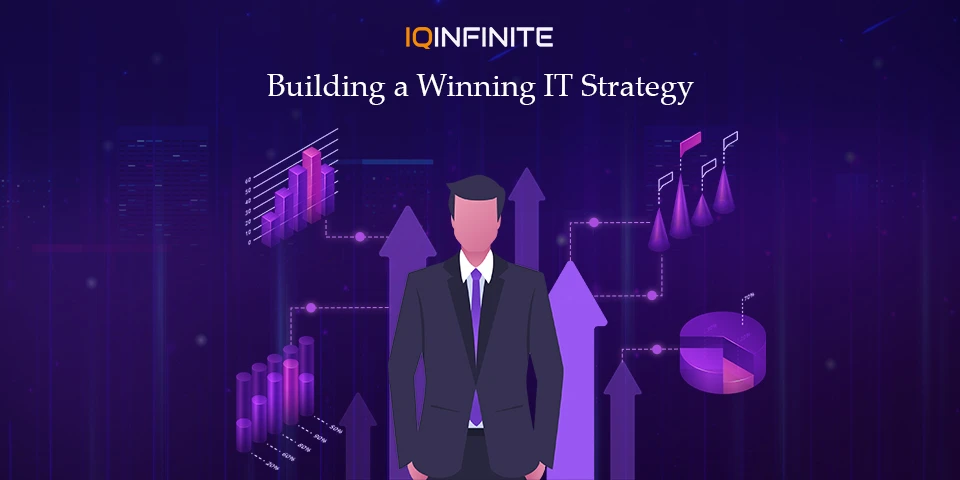How to develop an effective IT Strategy for your Business

In today’s fast-paced digital landscape, technology is no longer just a support function it’s the driving force behind business growth and innovation. A well-crafted IT strategy bridges technology with business objectives, ensuring every digital investment delivers measurable value. Whether you’re a nimble startup or a global enterprise, a clear IT roadmap empowers you to stay competitive, agile and secure, turning technological potential into tangible business success.
1. Understand Your Business Goals
Before diving into technology, start with the “why”. A successful IT strategy is always aligned with your business objectives, whether that’s scaling operations, enhancing customer experience or strengthening data security.
Ask yourself key questions:
• What are the short-term and long-term goals of my business?
• Which processes require optimization or automation?
• What challenges or inefficiencies are slowing growth?
By aligning your IT initiatives with your overall business vision, every technology decision becomes a strategic step forward.
Ask yourself key questions:
• What are the short-term and long-term goals of my business?
• Which processes require optimization or automation?
• What challenges or inefficiencies are slowing growth?
By aligning your IT initiatives with your overall business vision, every technology decision becomes a strategic step forward.
2. Assess Your Current IT Infrastructure
Take a close look at your existing systems, tools and workflows. Understanding your current IT environment helps identify gaps and opportunities for improvement.
Focus on evaluating:
• Hardware and software performance
• Data storage and backup systems
• Network reliability and cybersecurity posture
• IT support and maintenance processes
A thorough assessment forms the foundation for smarter planning and accurate budgeting.
Focus on evaluating:
• Hardware and software performance
• Data storage and backup systems
• Network reliability and cybersecurity posture
• IT support and maintenance processes
A thorough assessment forms the foundation for smarter planning and accurate budgeting.
3. Identify Technology Opportunities
With clear goals and an understanding of your current infrastructure, the next step is identifying technologies that bridge the gap between today and your desired future state.
Key areas to consider:
• Cloud Solutions: Enhance scalability and flexibility.
• Automation Tools: Increase productivity and reduce manual errors.
• AI & Analytics: Enable data-driven decision-making.
• Cybersecurity Solutions: Protect sensitive data and ensure compliance.
• CRM & ERP Systems: Streamline operations and improve customer management.
Prioritize technologies that deliver measurable ROI and align with your business size and maturity.
Key areas to consider:
• Cloud Solutions: Enhance scalability and flexibility.
• Automation Tools: Increase productivity and reduce manual errors.
• AI & Analytics: Enable data-driven decision-making.
• Cybersecurity Solutions: Protect sensitive data and ensure compliance.
• CRM & ERP Systems: Streamline operations and improve customer management.
Prioritize technologies that deliver measurable ROI and align with your business size and maturity.
4. Prioritize and Create a Roadmap
Not every initiative can be implemented at once. Prioritize projects based on their business impact, cost and urgency.
Your roadmap should include:
• Project timelines and milestones
• Budget allocation
• Responsible teams or stakeholders
• Success metrics
A structured roadmap ensures accountability and smooth execution of your IT initiatives.
Your roadmap should include:
• Project timelines and milestones
• Budget allocation
• Responsible teams or stakeholders
• Success metrics
A structured roadmap ensures accountability and smooth execution of your IT initiatives.
5. Strengthen Your Cybersecurity Framework
Cyber threats are growing more sophisticated every day. A proactive, integrated security strategy is essential.
Key actions:
• Implement multi-layered security systems
• Conduct regular audits and vulnerability assessments
• Train employees on data protection best practices
• Establish robust data backup and disaster recovery protocols
A secure IT environment not only protects your assets but also builds customer trust and business resilience.
Key actions:
• Implement multi-layered security systems
• Conduct regular audits and vulnerability assessments
• Train employees on data protection best practices
• Establish robust data backup and disaster recovery protocols
A secure IT environment not only protects your assets but also builds customer trust and business resilience.
6. Invest in People and Skills
Technology is only as effective as the people managing it. Ensure your workforce is skilled, adaptable and aligned with your IT vision.
Ways to invest in your team:
• Provide training on new tools and platforms
• Hire specialists where necessary
• Foster a culture of innovation and digital adoption
A knowledgeable, empowered team accelerates transformation and reduces dependency on external vendors.
Ways to invest in your team:
• Provide training on new tools and platforms
• Hire specialists where necessary
• Foster a culture of innovation and digital adoption
A knowledgeable, empowered team accelerates transformation and reduces dependency on external vendors.
7. Monitor, Evaluate and Evolve
An IT strategy is never static. Continuously monitor performance, evaluate outcomes and adapt to changes in technology and market conditions.
Track metrics such as:
• System uptime and operational efficiency
• Cost savings achieved
• Security incidents prevented
• Employee productivity improvements
Flexibility is key be ready to pivot your strategy as your business grows and evolves.
Track metrics such as:
• System uptime and operational efficiency
• Cost savings achieved
• Security incidents prevented
• Employee productivity improvements
Flexibility is key be ready to pivot your strategy as your business grows and evolves.
Conclusion
An effective IT strategy elevates technology from a mere support function to a powerful driver of business growth. By seamlessly aligning IT with organizational objectives, streamlining infrastructure, embracing emerging technologies and nurturing talent, your business can stay ahead of the curve competitive, secure and fully prepared for the challenges of tomorrow.
